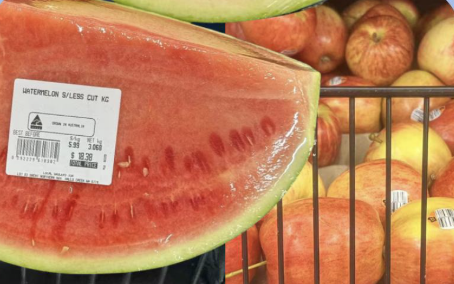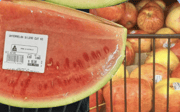
When Perth-based advocate Megan Krakouer walked through a small supermarket in Halls Creek last August, she couldn't believe her eyes.
Tomatoes priced at nearly $12 per kilogram, watermelon at $6 per kilogram—prices that would make even the most budget-conscious shopper's jaw drop.
But what Krakouer discovered isn't just an isolated problem in Western Australia's remote Kimberley region. It's part of a national crisis that's forcing thousands of Australians to choose between eating well and paying their bills.
A shocking new investigation by consumer advocacy group CHOICE has revealed the true extent of Australia's remote food pricing crisis.
When they mystery-shopped four remote community stores across Western Australia and the Northern Territory, they found that a basket of nine basic grocery items cost an average of $99.38—more than double the $44.70 you'd pay for the same items in capital cities.
'We're living in a cost-of-living crisis—how are people supposed to be able to feed their families healthily with prices like this?'
The numbers are staggering enough, but the reality behind them is even more troubling. In one remote store, CHOICE found tins of canned tomato soup selling for $7 compared to $2.50 in major supermarkets, while a tin of Spam was priced at $11 versus the usual $6.80 in capital cities. CHOICE Remote Store Analysis
A quarter watermelon for $18? Welcome to remote Australia
Back in the Kimberley, the situation Krakouer witnessed represents daily life for thousands of Australians. At small-town supermarkets across Western Australia's far north, you might pay $18 for a quarter of a watermelon or fork out $30 for a kilogram of truss tomatoes.
Compare that to Sydney or Melbourne, where you'd pay around half that price for watermelon and three times less for tomatoes.
The price disparity becomes even more stark when you look at basic fruits. In Fitzroy Crossing, red gala apples were selling for $12.99 per kilogram and pears for $10.99. Even in the larger coastal town of Broome, those same apples still cost $8.90 per kilogram—nearly double what metropolitan shoppers pay.
The remote food price crisis by the numbers
- Remote grocery baskets cost 120 per cent more than in capital cities
- Some items cost up to 3 times more than metropolitan prices
- Remote areas pay 21-62 per cent more for groceries than district centres
- Fruit prices nationally have increased 12.3 per cent in the past year
Former Halls Creek health worker Marianne Nungarri Skeen sees the health consequences daily. 'It's a vicious cycle that needs to be stopped,' she said. 'We need to have something better in place.' When fresh food is priced out of reach, families turn to processed alternatives, contributing to higher rates of diabetes, heart disease, and kidney problems in remote communities.
Why your postcode determines your grocery bill
The Australian Competition and Consumer Commission found that prices are 'significantly higher' in remote locations due to freight costs and lack of competition. Wayne Bergmann, managing director of Leedal Pty Ltd which owns Fitzroy Crossing's Tarunda IGA, breaks down the brutal economics: 'On average across the board, we probably spent about $700,000 a year on freight.' Add to that over $1 million annually in insurance costs that doesn't even cover floods, and you begin to understand the challenge.
But freight is just part of the story. Remote stores face a perfect storm of cost pressures: small populations mean lower sales volumes, worker shortages drive up labour costs, and with often just one store serving an entire region, there's no competition to drive prices down.
The hidden costs of remote retail
Transport and logistics: $700,000 annually for a single store
Insurance: Over $1 million per year (excluding flood coverage)
Worker shortages: Premium wages needed to attract staff
Limited competition: Often just one store per town
Small scale: Lower volumes mean higher per-unit costs
Bergmann acknowledges the social responsibility his store carries. 'We see the supermarket in Fitzroy as a bit of a social responsibility,' he said. 'I don't think we're the cheapest but I think we're in between.' The store has implemented strategies like selling blemished produce at lower prices and sourcing meat from local pastoral stations to help reduce costs.
When government solutions miss the mark
The federal government launched its Low-Cost Essentials Subsidy Scheme in July 2024, initially promising to reduce costs on 30 essential items across 152 remote stores. However, fresh fruit, vegetables, and meat—the items residents most desperately need—have largely been excluded from the program.
Indigenous Australians Minister Malarndirri McCarthy has highlighted the health implications, noting high rates of kidney disease, rheumatic fever, and diabetes in remote communities. 'What we want to see is food products that actually assist in healthy living,' McCarthy told ABC Radio.
The government cites the program delivery company's lack of 'cold storage capacity' for the focus on canned goods instead of fresh produce. But as Fitzroy Crossing nutritionist Clint Bussey points out, 'With tinned items, when people consume these regularly their salt intake increases, so then you get things like renal diseases and high blood pressure.'
Did you know?
What does this mean for you?
Even if you don't live in a remote area, this crisis affects all Australians. The health costs of poor nutrition in remote communities ultimately impact our healthcare system and tax base. Plus, if you're planning to travel or move to regional Australia, understanding these price differences is crucial for budgeting.
The human cost of expensive groceries
Financial counsellor Bettina Cooper from Mob Strong Debt Help, who travels to remote communities, puts it simply: 'When we're travelling to remote communities there's often only one choice of a local store. So whatever price is there is the price you pay.' CHOICE Remote Communities Report
For families relying on Centrelink payments or minimum-wage jobs, these prices create impossible choices. Patrick Davies, a Fitzroy Crossing resident, notes that 'the employment benefits that people do receive don't necessarily meet the needs of families.' Some residents drive hours to larger towns like Broome or Derby to shop, but that means fuel costs and time away from work or family.
The ripple effects extend beyond individual households. The National Indigenous Australians Agency is developing a National Strategy for Food Security in Remote First Nations Communities, recognising that 'access to nutritious affordable food is critical to improving health outcomes in remote communities and building better futures'.
Hope on the horizon?
Despite the challenges, there are some positive developments. The Indigenous Consumer Assistance Network reports that communities like Wujal Wujal in Far North Queensland are experiencing better food prices since a new community-controlled store opened.
Consumer advocacy groups including CHOICE, along with First Nations organisations, have submitted recommendations to the government including exploring price caps on essential items and mandatory pricing information on all products.
Did you know?
Did you know?
While 11 out of 19 Closing the Gap targets are showing improvement, only five are currently on track to be met, according to Prime Minister Anthony Albanese. Addressing food security in remote communities is considered crucial to closing health and economic gaps for Indigenous Australians.
What needs to happen next
The scale of this problem demands urgent action beyond the current subsidy scheme. Financial counsellor Lynda Edwards argues that 'policymakers should also consider increasing social security benefits to better reflect the actual cost of living in extremely remote communities,' noting that 'the current system that's in place now is just not working.'
Solutions could include:
- Expanding the subsidy scheme to include fresh produce with proper cold storage infrastructure
- Investigating price caps on essential items in consultation with communities
- Increasing social security payments for remote area residents
- Supporting community-controlled stores and local food production initiatives
- Improving transport infrastructure to reduce freight costs
The data is clear: Australians shouldn't have to pay double or triple for basic groceries simply because of where they live. When a tin of soup costs nearly three times more in a remote community than in a capital city, we're not just talking about market forces—we're talking about basic fairness and access to nutrition.
What This Means For You
The conversation needs to shift from accepting these price disparities as inevitable to recognising them as a barrier to health, wellbeing, and equality. Every Australian deserves access to affordable, nutritious food—regardless of their postcode.
Have you experienced shocking grocery prices while travelling in remote areas? What solutions do you think would make the biggest difference for families struggling with these costs? Share your thoughts and experiences below.
Original Article
https://www.abc.net.au/news/2025-09-30/fruit-and-vegetable-prices-remain-high-in-kimberley/105749056
Groceries cost more than twice as much in some remote First Nations communities | CHOICE
Cited text: · 'The basket of nine items, all of which can be considered essentials, cost $44.70 when averaged out across Woolworths, Coles, Aldi and IGA across al...
Excerpt: When they mystery-shopped four remote community stores across Western Australia and the Northern Territory, they found that a basket of nine basic grocery items cost an average of $99.38—more than double the $44…
https://www.choice.com.au/about-us/...much-in-some-remote-first-nations-communities
Groceries cost more than twice as much in remote First Nations communities | CHOICE
Cited text: We found tins of canned tomato soup, which would sell for $2.50 at a major supermarket in a capital city, priced at $7 here. A tin of spam meat which ...
Excerpt: CHOICE found tins of canned tomato soup selling for $7 compared to $2.50 in major supermarkets, while a tin of Spam was priced at $11 versus the usual $6.80 in capital cities.
https://www.choice.com.au/shopping/.../articles/remote-first-nations-grocery-stores
What the average Aussie spends on groceries in 2025 | Finder
Cited text: For example, groceries are on average 21 per cent to 62 per cent more expensive in remote and regional areas of the NT compared to district centres like Darwin or Ali...
Excerpt: Remote areas pay 21-62 per cent more for groceries than district centres
https://www.finder.com.au/budgeting/average-grocery-bill
What the average Aussie spends on groceries in 2025 | Finder
Cited text: If we look at just groceries, price increases between January 2024 and January 2025 range from 3 per cent for bread to 12.3 per cent for fruit.
Excerpt: Fruit prices nationally have increased 12.3 per cent in the past year
https://www.finder.com.au/budgeting/average-grocery-bill
Nine grocery items bill tops $100 in remote community
Cited text: Choice found the average price of a basket of 10 grocery items in these remote communities was $99.38—more than double the cost of the same items in...
Excerpt: The Australian Competition and Consumer Commission found that prices are 'significantly higher' in remote locations due to freight costs and lack of competition.
https://www.thenewdaily.com.au/news/indigenous-news/2024/10/31/groceries-expensive-indigenous
The Hidden Cost of Living in Remote Australia: Sky-High Prices Finally Addressed
Cited text: Indigenous Australians Minister Malarndirri McCarthy highlighted the importance of reducing the financial strain on regional residents, saying the gov...
Excerpt: Indigenous Australians Minister Malarndirri McCarthy has highlighted the health implications, noting high rates of kidney disease, rheumatic fever, and diabetes in remote communities.
https://en.econostrum.info/au/cost-of-living-remote-australia-high-prices/
Nine grocery items bill tops $100 in remote community
Cited text: “If you’re on a low wage or a Centrelink payment, with a high cost of living, then you are making a choice between what meals you don’t have,” Mob Str...
Excerpt: 'With tinned items, when people consume these regularly their salt intake increases, so then you get things like renal diseases and high blood pressure.'
https://www.thenewdaily.com.au/news/indigenous-news/2024/10/31/groceries-expensive-indigenous
Groceries cost more than twice as much in remote First Nations communities | CHOICE
Cited text: · Boandik woman Bettina Cooper is a financial counsellor with Mob Strong Debt Help and says the high prices seen in communities on the Tiwi Islands ar...
Excerpt: Financial counsellor Bettina Cooper from Mob Strong Debt Help, who travels to remote communities, puts it simply: 'When we're travelling to remote communities there's often only one choice of a local store.
https://www.choice.com.au/shopping/.../articles/remote-first-nations-grocery-stores
Groceries cost more than twice as much in remote First Nations communities | CHOICE
Cited text: So whatever price is there is the price you pay,' she says.
Excerpt: Financial counsellor Bettina Cooper from Mob Strong Debt Help, who travels to remote communities, puts it simply: 'When we're travelling to remote communities there's often only one choice of a local store.
https://www.choice.com.au/shopping/.../articles/remote-first-nations-grocery-stores
Groceries cost more than twice as much in remote First Nations communities | CHOICE
Cited text: The National Indigenous Australians Agency (NIAA) is currently in the process of developing a National Strategy for Food Security in Remote First Nati...
Excerpt: The National Indigenous Australians Agency is developing a National Strategy for Food Security in Remote First Nations Communities, recognising that 'access to nutritious affordable food is critical to improving health outcomes in remote…
https://www.choice.com.au/shopping/.../articles/remote-first-nations-grocery-stores
Groceries cost more than twice as much in remote First Nations communities | CHOICE
Cited text: ICAN, which works extensively throughout Far North Queensland, told CHOICE communities like Wujal Wujal, where a new CEQ store recently opened, are ex...
Excerpt: The Indigenous Consumer Assistance Network reports that communities like Wujal Wujal in Far North Queensland are experiencing better food prices since a new community-controlled store opened.
https://www.choice.com.au/shopping/.../articles/remote-first-nations-grocery-stores
Groceries cost more than twice as much in remote First Nations communities | CHOICE
Cited text: · In a joint submission to the NIAA, CHOICE along with First Nations organisations such as Mob Strong Debt Help and the Indigenous Consumer Assistance...
Excerpt: Consumer advocacy groups including CHOICE, along with First Nations organisations, have submitted recommendations to the government including exploring price caps on essential items and mandatory pricing information on all products.
https://www.choice.com.au/shopping/.../articles/remote-first-nations-grocery-stores
The Hidden Cost of Living in Remote Australia: Sky-High Prices Finally Addressed
Cited text: According to ABC News, Prime Minister Anthony Albanese acknowledged that while 11 out of 19 Closing the Gap targets are seeing some improvement, only ...
Excerpt: While 11 out of 19 Closing the Gap targets are showing improvement, only five are currently on track to be met, according to Prime Minister Anthony Albanese.
https://en.econostrum.info/au/cost-of-living-remote-australia-high-prices/
Groceries cost more than twice as much in remote First Nations communities | CHOICE
Cited text: · Policymakers should also consider increasing social security benefits to better reflect the actual cost of living in extremely remote communities · ...
Excerpt: Financial counsellor Lynda Edwards argues that 'policymakers should also consider increasing social security benefits to better reflect the actual cost of living in extremely remote communities,' noting that 'the current system that's in…
https://www.choice.com.au/shopping/.../articles/remote-first-nations-grocery-stores







